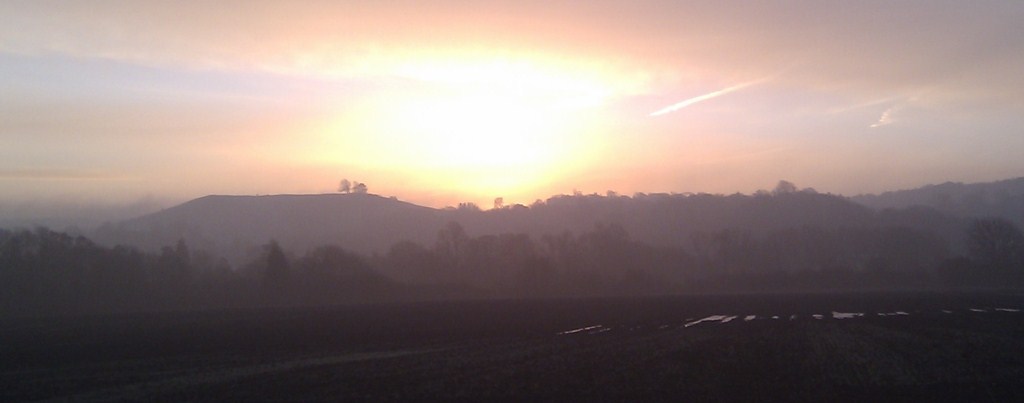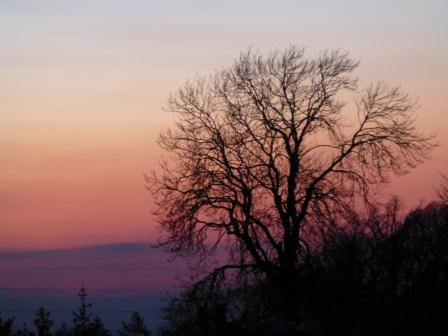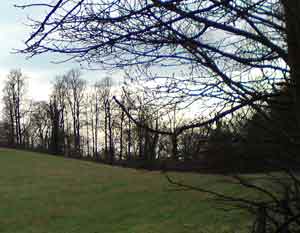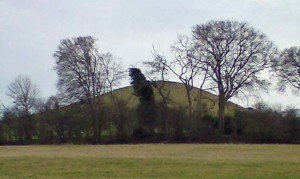
I was walking to the station a few days ago — the long way round because the footpath over the fields is too muddy (see the melting snow in the photo) and noticed a wonderful sunrise emerging over the tops of the Chiltern Hills, specifically Beacon Hill and Pulpit Hill (to the left and right respectively). I took a quick couple of photos with my phone and thought no more about them until I came to download some other photos to my laptop — and then was blown away by the way the camera had captured the moment. (The photo above hasn’t been altered in colour by any photo-editing software).
The beaming, beacon-like sun means I like this photo in a slightly superstitious, borderline-karmic way too because in my mind, the imaginary village where much of the novel is located approximately under where the sun is breaking through the clouds — just on over the scarp of Chilterns. In reality, there is already a steaming hot-bed of scandal and highly-secret political intrigue nestling on the other side of those hills. It’s called Chequers — and while what goes on in there is no doubt stranger than fiction, its stories are subject to the hundred years rule.
There’s something also a little Turner-like about the yellow blast of light spilling over so much of the sky between the hills, which also ties in with the novel. One of the reasons Kim considers leaving London for the countryside is that she wants to paint landscapes — something there’s limited scope to do in Shoreditch and Hackney. A German artist coming to Britain also draws on a strong tradition for landscape painting common to both countries — and a subject I’ve been learning about as I’ve been writing the novel.
Caspar David Friedrich is a dominant figure in early nineteenth century German art and his landscape paintings depict a romantic melancholy that, it could be argued, reflects a strand of the German character – certainly a phlegmatic love of the open-air. I recently went to a lunchtime lecture at the National Gallery titled Caspar David Friedrich and the Tragedy of the Landscape, which rattled through slides of dozens of his paintings, accompanied by an illuminating commentary. Kim will know Friedrich inside out.
Friedrich was a contemporary of the great British Romantic landscape artists, notably Constable and Turner, whose most famous paintings, such as The Hay Wain or The Fighting Temeraire, hang in the likes of the National Gallery. I went to the last weekend of the current Constable, Gainsborough, Turner and the Making of Landscape exhibition at the Royal Academy yesterday and saw a few of the lesser known paintings by the famous three in the exhibition’s title, as well as examples by many of their lesser known predecessors. Turner’s fishing rod was also exhibited!
However, the National Gallery’s Room 34, in which those two painting hang either side of the entrance door, always awes me. Unlike writers, whose physical works are interesting curiosities but lose nothing in reproduction, painters’ original works are fascinating in person because of their physicality. It’s fascinating to stand close to the Turners, in particular, and see the brush strokes and the varying thicknesses of paint on the canvas — there’s a direct connection between artist and viewer that’s unique in painting.
I had the chance at the Tate Britain’s new Looking at the View landscape exhibition to see the original of a print that hangs on the wall above my computer at home — John Nash’s wonderful The Cornfield (sadly the Tate’s website doesn’t show an image of the painting but instead suggests his The Moat, Grange Farm, Kimble, which is of a landscape less half a mile away from where I’m currently typing).
I’d looked before for The Cornfield in the Tate and found it not on display so was very pleased to see it hung in the exhibition. I spent several minutes looking carefully at the way Nash had created the authentic, yet modernist, representation of wheatsheaves and summer foliage in the original. It was also fascinating to stand back from the painting in the gallery and observe the way Nash had cast the low sunlight and lengthening shadows across the painting. Painted in the last summer of the First World War in 1918 in the Chilterns near Chalfont St. Giles, it’s such a beautifully understated painting that both nods back to the Romantic tradition and anticipates the disruptions of the early twentieth century that it features on the cover of the book of the David Dimbleby A Picture of Britain series of a few years ago.
The Looking at the View exhibition displays many classic works but chooses to display these alongside more modern works — often photographic — and so seeks to show that landscape painting is a vibrant part of the contemporary art scene — and not just about haystacks and water mills. For example, there’s a series of 56 photos called Concorde Grid by Wolfgang Tillman. They’re all taken around Heathrow Airport’s perimeter, in Hatton Cross, Cranford and Hounslow West in 1997 and, in addition to Concorde passing over , they feature things like the BA maintenance base (inside which I worked for four years and close by for an additional eight), the road sign on the A30 and what seems like a scrapyard on Hatton Road.
As the Tate exhibition shows (it runs until June), landscape is something that still holds a fascination for both artist and viewer and there’s plenty of scope for Kim to move to the landscape of the photo above and start to paint her own unique synthesis of Germanic melancholy, English pastoral, Berlin reinvention and Shoreditch cool.
And, in doing so, she’s almost retracing the journey of another famous (real) German artist — Kurt Schwitters — co-incidentally also the subject of a major current exhibition at Tate Britain, Schwitters in Britain, which I’ve also seen. Schwitters is most known for his collages, the lasting effect of which can be seen even now in most graphic art (e.g. magazines), inspired by his concept of Merz.
Like Kim, Schwitters came from Hanover, where much of his work is now curated in the Sprengel Museum. I used to go to Hanover at least a dozen times a year over a period of eight or nine years so I may have picked up Schwitters’s story without realising it. (I certainly remember the Sprengel Museum itself — it was near the Machsee, location for a wonderful beer and bratwurst festival in the summer.) But Schwitters being an entartete Kunst, he sensibly fled to Norway and then to Britain. He was interned for a while in the Isle of Man and the Tate exhibition has his original application, made whilst interned, to remain in the UK. It is typed in faltering English, describing himself being ‘called by the Nazis’ for being ‘a degenerated artist’.
The form is humbling and heartbreaking to read but also hugely uplifting, because the application was eventually successful and Schwitters was released to live freely in London. He subsequently moved to Ambleside in the Lake District, where he made a living by painting portraits and also made many paintings of the dramatic local landscapes. In 1948 Schwitters learned he’d been granted British citizenship — on the day before he died .




